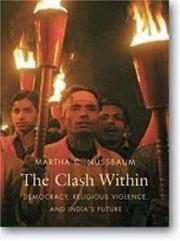| Listing 1 - 3 of 3 |
Sort by
|
Book
ISBN: 9781611861167 1611861160 Year: 2014 Publisher: East Lansing: Michigan state university press,
Abstract | Keywords | Export | Availability | Bookmark
 Loading...
Loading...Choose an application
- Reference Manager
- EndNote
- RefWorks (Direct export to RefWorks)
In the beginning, says the ancient Hindu text the Rg Veda, was man. And from man’s sacrifice and dismemberment came the entire world, including the hierarchical ordering of human society. The Head Beneath the Altar is the first book to present a wide-ranging study of Hindu texts read through the lens of René Girard’s mimetic theory of the sacrificial origin of religion and culture. For those interested in Girard and comparative religion, the book also performs a careful reading of Girard’s work, drawing connections between his thought and the work of theorists like Georges Dumézil and Giorgio Agamben. Brian Collins examines the idea of sacrifice from the earliest recorded rituals through the flowering of classical mythology and the ancient Indian institutions of the duel, the oath, and the secret warrior society. He also uncovers implicit and explicit critiques in the tradition, confirming Girard’s intuition that Hinduism offers an alternative anti-sacrificial worldview to the one contained in the gospels.
Hindu mythology. --- Sacrifice --- Violence --- Hinduism. --- Religious aspects --- Girard, René, --- Girard, René, --- Girard, René --- Sacrifice - Hinduism. --- Violence - Religious aspects - Hinduism. --- Girard, René, - 1923-2015.

ISBN: 2713210143 9782713210143 2713231353 Year: 1994 Volume: 16 Publisher: Paris: École des hautes études en sciences sociales,
Abstract | Keywords | Export | Availability | Bookmark
 Loading...
Loading...Choose an application
- Reference Manager
- EndNote
- RefWorks (Direct export to RefWorks)
Comment comprendre que des ascètes aient développé en Inde une tradition martiale extrêmement élaborée, tout en ayant fait des vœux stricts de « non-violence » ? Et comment se fait-il que des leaders syndicalistes à poigne puissent se réclamer avec conviction des mêmes idéaux que Gandhi, ou encore que des brahmanes hésitent aussi peu à manier le bâton tout en affichant haut et fort leur foi dans la non-violence ? De telles façons d’agir, souvent paradoxales à nos yeux, sont susceptibles cependant de renouveler notre compréhension des notions de violence et de non-violence dans la société indienne, contredisant en particulier l'idée que l’on s’en fait habituellement depuis le gandhisme. Douze études, portant sur des périodes, des lieux, des protagonistes fort divers, montrent que, bien souvent, la non-violence est ce au nom de quoi la violence se légitime, ce qui lui confère du sens. Mais la valorisation de « la » non-violence repose sur des interprétations en réalité très variées de cette expression, et sur des rapports de force qui relativisent et hiérarchisent des points de vue distincts, tout en permettant leur maintien.
Violence --- Nonviolence --- Religious aspects --- Hinduism. --- Violence - Religious aspects - Hinduism. --- Nonviolence - Religious aspects - Hinduism. --- Violence - India. --- Nonviolence - India. --- Social Sciences, Interdisciplinary --- violence --- magie --- musulman --- non-violence --- brahmanisme --- Inde coloniale --- hindou

ISBN: 9780674024823 0674024826 Year: 2007 Publisher: Cambridge: Belknap press of Harvard university press,
Abstract | Keywords | Export | Availability | Bookmark
 Loading...
Loading...Choose an application
- Reference Manager
- EndNote
- RefWorks (Direct export to RefWorks)
Indian religions --- Hindutva. --- Communalism --- Hinduism and state. --- Violence --- Democracy --- Religious fanaticism --- Communalisme --- Hindouisme et Etat --- Démocratie --- Fanatisme religieux --- Religious aspects --- Hinduism. --- Aspect religieux --- Hindouisme --- Hindutva --- Hinduism and state --- Hinduism --- Fanaticism --- Violent behavior --- Social psychology --- State and Hinduism --- State, The --- Hindu nationalism --- Nationalism --- Démocratie --- Religious aspects&delete& --- Communalism - India --- Violence - Religious aspects - Hinduism --- Democracy - India --- Religious fanaticism - Hinduism
| Listing 1 - 3 of 3 |
Sort by
|

 Search
Search Feedback
Feedback About UniCat
About UniCat  Help
Help News
News